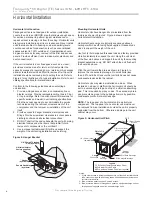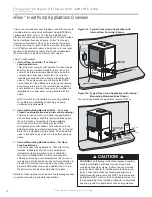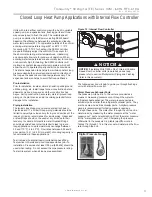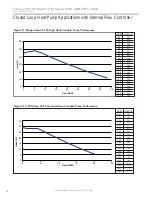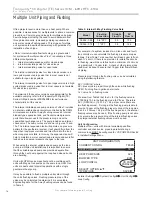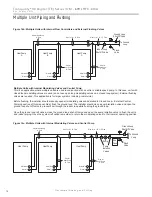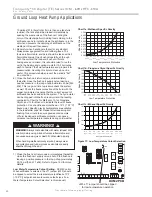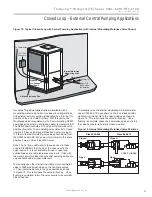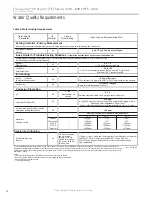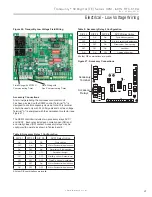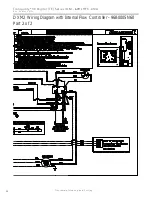
19
c l i m a t e m a s t e r. c o m
Tranquility
®
30 Digital (TE) Series IOM - 60Hz HFC-410A
R e v. : 2 9 M a y, 2 0 1 5 J
Ground Loop Heat Pump Applications
Table 3: Fluid Volume
WARNING!
Fluid Volume (gal [liters] per 100’ [30 meters] Pipe)
Pipe
Size
Volume (gal) [liters]
Copper
1”
4.1 [15.3]
1.25”
6.4 [23.8]
2.5”
9.2 [34.3]
Polyethylene
3/4” IPS SDR11
2.8 [10.4]
1” iPS SDR11
4.5 [16.7]
1.25” IPS SDR11
8.0 [29.8]
1.5” IPS SDR11
10.9 [40.7]
2” IPS SDR11
18.0 [67.0]
Unit Heat Exchanger
Typical
1.0 [3.8]
Flush Cart Tank
10” Dia x 3ft tall
[254mm x 91.4cm tall]
10 [37.9]
Table 4: Antifreeze Percentages by Volume
Type
Minimum Temperature
for Low Temperature Protection
10°F
[-12.2°C]
15°F
[-9.4°C]
20°F
[-6.7°C]
25°F
[-3.9°C]
Methanol
Propylene Glycol
Ethanol*
21%
29%
23%
17%
24%
20%
13%
18%
16%
8%
12%
11%
* Must not be denatured with any petroleum based product
WARNING!
CAUTION!
Antifreeze Selection - General
In areas where minimum entering loop temperatures drop
below 40°F [4.4°C] or where piping will be routed through
areas subject to freezing, antifreeze is needed. Alcohols
and glycols are commonly used as antifreeze solutions.
Your local representative should be consulted for the
antifreeze best suited to your area. Freeze protection should
be maintained to 15°F [8.5°C] below the lowest expected
entering loop temperature.
Initially calculate the total volume of
fl
uid in the piping
system using Table 3. Then use the percentage by volume
shown in Table 4 for the amount of antifreeze. Antifreeze
concentration should be checked from a well mixed sample
using a hydrometer to measure speci
fi
c gravity.
Antifreeze Charging
It is highly recommended to utilize premixed antifreeze
fl
uid
where possible to alleviate many installation problems and
extra labor.
The following procedure is based upon pure antifreeze and
can be implemented during the Full Flush procedure with three
way valves in the Figure 15c - Valve Position C. If a premixed
mixture of 15°F [-9.4°C] freeze protection is used, the system
can be
fi
lled and
fl
ushed with the premix directly to prevent
handling pure antifreeze during the installation.
1) Flush loop until all air has been purged from system and
pressurize to check for leaks before adding
any antifreeze.
2) Run discharge line to a drain and hook up antifreeze
drum to suction side of pump (if not adding below
water level through approved container). Drain
fl
ush cart
reservoir down to pump suction inlet so reservoir can
accept the volume of antifreeze to be added.
3) Calculate the amount of antifreeze required by
fi
rst
calculating the total
fl
uid volume of the loop from Table 3.
Then calculate the amount of antifreeze needed using Table
4 for the appropriate freeze protection level. Many southern
applications require freeze protection because of exposed
piping to ambient conditions.
4) Isolate unit and prepare to
fl
ush only through loop (see
Figure 15a). Start
fl
ush cart, and gradually introduce the
required amount of liquid to the
fl
ush cart tank (always
introduce alcohols under water or use suction of pump
to draw in directly to prevent fuming) until attaining the
proper antifreeze protection. The rise in
fl
ush reservoir
level indicates amount of antifreeze added (some carts
are marked with measurements in gallons or liters). A
ten inch [25.4 cm] diameter cylinder, 3 foot [91.4 cm] tall
holds approximately 8 gallons [30.3 liters] of
fl
uid plus the
hoses (approx. 2 gallons, [7.6 liters], which equals about
Contact your ClimateMaster distributor if you have any
questions as to antifreeze selection.
WARNING!
Always dilute alcohols with water (at least 50%
solution) before using. Alcohol fumes are
fl
ammable and
can cause serious injury or death if not handled properly.
When handling methanol (or any alcohol), always wear
eye protection and rubber gloves as alcohols are easily
absorbed through the skin.
WARNING!
Always use properly marked vehicles (D.O.T.
placards), and clean/suitable/properly identi
fi
ed containers
for handling
fl
ammable antifreeze mixtures. Post and
advise those on the jobsite of chemical use and potential
dangers of handling and storage.
NOTICE:
DO NOT use automotive windshield washer
fl
uid
as antifreeze. Washer
fl
uid contains chemicals that will cause
foaming.
CAUTION!
Always obtain MSDS safety sheets for all
chemicals used in ground loop applications including
chemicals used as antifreeze.
Содержание Tranquility 30 TE026
Страница 2: ...This page was intentionally left blank ...


